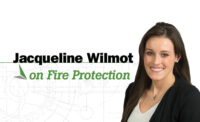Have you opened the latest edition of NFPA 13, Standard for the Installation of Sprinkler Systems, to check on a specific requirement and wondered if you opened the right book?
If so, you are not alone! For almost 15 years, the structure of the standard looked similar from one edition to the next, while incorporating technical changes that reflect our ever-changing world. However, in 2013, the idea to restructure NFPA 13 was brought to the table, and six years later it resulted in a reorganization for the 2019 edition.
Here is what you need to know:
Why was NFPA 13 reorganized?
The sole purpose of reorganizing NFPA 13 was to make the standard easier for users to follow and apply. In December 2013, the Correlating Committee of NFPA 13 instructed the four committees responsible for the development of NFPA 13 to streamline the standard so that it parallels the order that one would design a sprinkler system.
Prior to the 2019 edition, there were many redundant sections which have been consolidated. For example, some of the general requirements for the location of sprinklers were repeated in each subsection of the previous Chapter 8. These provisions are now only listed once in the new Chapter 9. The result? The document now is more concise without compromising the value of the content.
In addition, relevant information has been grouped and gaps have been filled. The most profound example of this can be found in the storage chapters, which allow the user to find the needed requirements based on the sprinkler technology that is being planned to protect the commodity.
What went where?
Chapters 1 through 3 basically remained the same. Chapter 1, the Administration Chapter, provides the purpose, concepts and foundational assumptions to apply the provisions of the standard.
Understanding the principles behind NFPA 13 is critical for a designer to properly apply the requirements. Definitions for terms used in NFPA 13 are associated with Chapter 3, which was reorganized to place the definitions in alphabetical order rather than by specific subject as it was outlined in previous editions.
Designing a sprinkler system
When it comes to designing a sprinkler system, where does one start? Identifying the occupancy classification and determining the available water supply are some of the first items a designer would need to consider. Prior to the 2019 edition, water-supply requirements were located in the back of the book in Chapter 24, which left users flipping between the front and back of the standard to coordinate plans. Water-supply requirements are now located in Chapter 5, only after the General Requirements Chapter.
In order to get the water from the available water supply to the occupancy the proposed sprinkler system is protecting, underground piping needs to be analyzed. That’s where Chapter 6 comes into play, providing the minimum requirements for the installation of underground piping. The types of materials and components that are acceptable for use in a sprinkler system, as well as the associated advantages and restrictions of those items, are followed in Chapter 7.
Once the occupancy classification has been determined, the available water supply is identified, and the installation of underground piping is analyzed, it is important to consider the types of sprinkler systems that could be utilized for the space that needs to be protected. The ambient temperature of the space to be protected, the expected type of fire, and defining the “success” of the sprinkler system, are critical steps to determine which sprinkler system is appropriate for the space to be protected.
Chapter 8 contains 10 subsections for each type of sprinkler system acknowledged in NFPA 13 (wet pipe, dry pipe, preaction and deluge, combined dry pipe and pre-action systems for piers, terminals and wharves, multi-cycle systems, antifreeze systems, outside sprinkler for protection against exposure fires, refrigerated spaces, commercial-type cooking equipment and ventilation and pilot-line detectors). The associated requirements for each system, as well as any limitations associated with that specific system, also are provided in Chapter 8.
Selecting the appropriate sprinkler system allows the designer to move onto the next step in the process, determining the type of sprinkler to use. One of the common design errors is the assumption that any given sprinkler can be used in all building construction types and for the protection of all occupancy hazard classifications. This is simply not true. Some sprinklers cannot be used in storage applications. Others are only permitted to be installed under a specific construction type such as smooth, flat ceilings, and some sprinklers are limited to a specific occupancy type.
Chapter 9 consolidates the general requirements and allowances for all sprinklers related to the specific location in which sprinklers are required to be installed. This includes a consolidated list of specific locations where sprinklers can be omitted, and the general requirements for the position, location and spacing for sprinklers.
In the 2016 edition of NFPA 13, a majority of time in Chapter 8 was spent steering through the subsections of everything that is now located in Chapter 9, and also reviewing the requirements that are specific to the type of sprinkler technology being used.
To many people’s pleasure, the 2016 edition of Chapter 8 was detonated in the 2019 edition. The general requirements are now consolidated into Chapter 9. Chapters 10 through 15 provide the more specific installation requirements based on the sprinkler technology being utilized:
Chapter 10: Standard Pendent, Upright, and Sidewall Spray Sprinklers
Chapter 11: Extended Coverage Upright, Pendent, and Sidewall Spray Sprinklers
Chapter 12: Residential Sprinklers
Chapter 13: CMSA Sprinklers
Chapter 14: ESFR Sprinklers
Chapter 15: Special Sprinklers
Chapter 16 follows up the sprinkler technology chapter by consolidating and coordinating all the installation requirements for individual components (sprinklers, valves, fittings, piping and attachments) with Chapter 7 covering requirements for system components and hardware.
The structural and seismic requirements to install fire protection systems were previously in the same chapter, and now each subject resides in chapters 17 and 18, respectively.
Hydraulic calculations was another area within NFPA 13 that used to be a pain to flip back and forth to coordinate the requirements between the previous Chapter 11 (Design Approaches), and Chapter 23 (Plans and Calculations). Now Chapter 19 contains the relevant requirements for sprinkler system discharge criteria for non-storage applications.
Navigating through the storage chapters
Parallel to chapters 9 through 15, Chapter 20 contains all the general storage requirements, and the subsequent chapters have specific provisions based on the sprinkler technology being used. The designer still needs to know the commodity classification and arrangement before opening to a specific chapter, but now he or she can select any of the following chapters based on the sprinkler technology being utilized:
Chapter 21: Protection of High Piled Storage Using Control Mode Density Area (CMDA) Sprinklers
Chapter 22: Control Mode Specific Application (CMSA) Requirements for Storage Applications
Chapter 23: Early Suppression Fast Response (ESFR) Requirements for Storage Applications
Chapter 34: Alternative Sprinkler System Designs for chapters 20 Through 25
Chapter 25: Protection of Rack Storage Using In-Rack Sprinklers
The “Special Occupancy Requirements” chapter was simply carried over from old Chapter 22 into new Chapter 26. This chapter contains extracted information regarding the design and installation criteria for automatic sprinkler systems for special occupancies in a single location.
Examples include, but are not limited to, flammable and combustible liquids, aerosol products, solvent extraction plans, laboratories using chemicals and protection of information technology equipment.
Plan, calculations and acceptance testing
At this point in the standard, NFPA 13 has outlined all the requirements necessary to start the plans and calculations of the sprinkler system.
Before an owner can receive the certificate of occupancy, an acceptance test is performed on the sprinkler system to confirm that it is compliant with NFPA 13. Chapter 28 provides the acceptance testing requirements for aboveground portions of the sprinkler system. If the user has a private fire service main, the requirements for that acceptance test are provided in Chapter 6, Installation of Underground Piping. Once the system has passed the acceptance test, the responsibility of the sprinkler system is officially turned over to the owner.
Another great feature in the 2019 edition is all the requirements related to existing system modifications are now located in one chapter, Chapter 29. Previously, system modification language was scattered throughout the standard, making it difficult for the user to find all the applicable requirements for existing system modifications.
Chapter 30 simply carries over the requirements for marine systems from the 2016 edition of Chapter 26.
Inspection, testing and maintenance
Chapter 31, the last chapter in the body of the standard, addresses the requirements for system inspection, testing and maintenance. This location is appropriate for the subject because once the system has passed the acceptance test, Chapter 31 requires that sprinkler systems be inspected, tested and maintained in accordance with NFPA 25.
The last portion of the document is dedicated to annex chapters, which contain unenforceable language (i.e., the term “should” is utilized rather than “shall”) and provides additional information that is often helpful to the end user. The following list contains the 2019 annex chapters:
Annex A: Explanatory Material
Annex B: Miscellaneous Topics
Annex C: Explanation of Test Data and Procedures for Rack Storage
Annex D: Sprinkler System Information from the 2018 Edition of the Life Safety Code
Annex E: Development of the Design Approach to Conform with ASCE/SEI7 and Suggested Conversion Factor Adjustments for Locations Outside the United States
Annex F: Informational References
Both the NFPA 13 standard and associated handbook provide a roadmap to help users familiar with the 2016 edition locate material in the 2019 edition. For more information, visit www.nfpa.org/13.
“Never memorize something you can look up” – Albert Einstein



